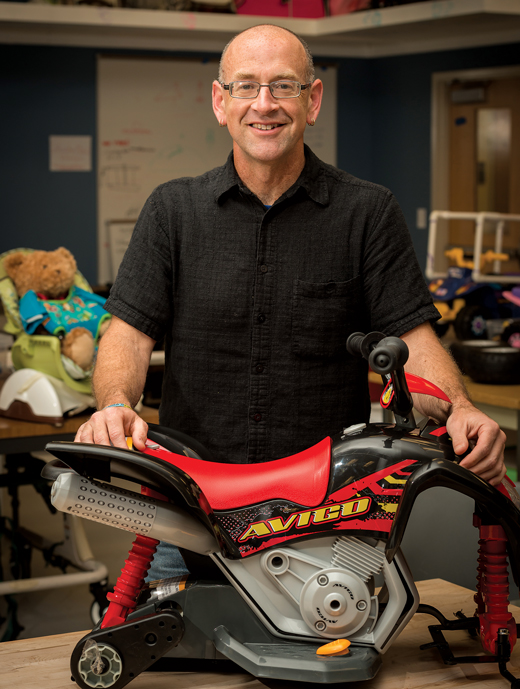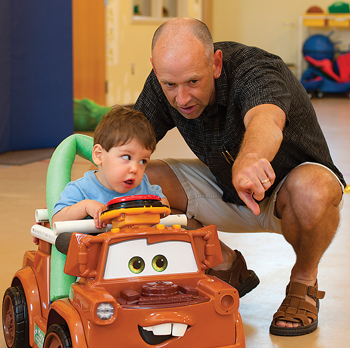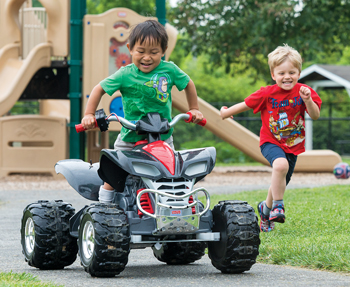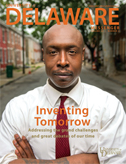

Getting Mobile,
Going Global
OUR UD | Three blonde-haired boys race around their back yard on New Zealand’s South Island. Two ride bikes, while the third, Miro, drives his flashy new sunflower-yellow BMW convertible.
It’s the first time Miro has been able to keep up with his brothers, but the ride-on car is much more than a toy for the 3-year-old with cerebral palsy. With the throttle in the headrest, Miro works hard to hold his head up because that’s the only way to make the car move.

“It will be great for him to go to ‘Bike Day’ and not be in his pram,” says his mother. “Now he can take his car instead and be the cool dude.”
No one understands better than Cole Galloway how important it is for a kid to be the cool dude.
Founder of the research-based GoBabyGo program, Galloway has made a career out of helping kids with special needs get moving so that they can be part of the social scene.

“Independent movement is critical to unlocking children’s social, emotional and cognitive skills,” he says. “We move our bodies to signify our identity in the world. To leave your mark on the world, you’ve got to actually be able to make a mark on the world.”
Beyond the “speed of science”
Galloway’s campaign to get kids as young as 6 months “driving” started with mobile robots he developed in collaboration with mechanical engineer Sunil Agrawal, who now teaches at Columbia University.
But demand very quickly outstripped supply, so Galloway turned to off-the-shelf toy cars that could be modified with common materials like fabric, foam, PVC pipe and simple switches to meet the needs of specific children.
His mark now goes far beyond Delaware, with more than half a dozen international sites to help children with critical movement disorders like cerebral palsy and spina bifida.
“Our program was moving at the speed of science,” he says. “I don’t want to downplay the importance of the science behind what we’re doing, but we realized that every year it took to collect and analyze data was another year that a group of young children was sitting and watching life go by. So now we’re doing the research in parallel with getting kids moving.”
Helping toddlers throw tantrums
Natalie, who has Down syndrome, began driving one of the mobile robots when she was less than a year old. At 2, she was tooling around in a “Tow Mater” Cars car, and now, at 4, she’s climbing stairs, going to birthday parties and meeting with legislators in Dover.
For Natalie, the car promoted cognitive, emotional and social development until her body began to catch up and she learned to walk.
Lately, she’s even learned to be defiant.
While that might at times frustrate her parents and big sister, defiance is critical to development, and it’s tied to mobility.
“What kind of world would it be if children weren’t developing independent mobility?” Galloway asked the audience at a talk he delivered at TEDMED 2014 in Washington, D.C.
“Think of a toddler unable to throw a tantrum. Tantrum-less toddlers would be much easier to live with, easy to make decisions for, easier to control…easier to ignore, to disrespect, to marginalize to the point of invisibility.”
It’s a lot tougher to disrespect a kid who can decide, on his or her own, when and where to move.
GoBabyGo across the globe
Sparked by Galloway’s work, people across the globe are joining forces to purchase cars and outfit them with roll bars, head switches, four-point seatbelts and other features to help young children bridge the gap between themselves and their peers.
In Canada, Holden has a customized Corvette that lets him cruise alongside his sister on family walks.
GoBabyGo goes to Washington
Thousands of parents, clinicians, students and community members from across the world have helped to modify toy ride-on cars for kids with disabilities through the University of Delaware’s GoBabyGo program.
Now, the Smithsonian is offering kids the chance to get creative with the cars.
For the next two months, a bright purple ride-on Ford F-150 will be part of a new exhibit at the Draper Spark!Lab in the Smithsonian’s Lemelson Center for the Study of Invention and Innovation. (The exhibit, on display since the summer, will run through Oct. 31.)
Spark!Lab, which has the look and feel of an inventor’s work space, invites children between the ages of 6 and 12 to “create, collaborate, explore, test, experiment and invent.”
The activities throughout the room are centered on key steps in the invention process: identifying a problem or need, conducting research, making sketches, building prototypes and testing, refining and marketing the invention.
For the GoBabyGo activity, participants are offered an operational guide and an assortment of materials including PVC pipe, pool “noodles,” simple switches and foam kickboards to modify the truck so that it can be operated by a child with special mobility needs. They can then sit in the vehicle, which is on a stationary platform, and test out their inventive solutions.
“This is a wonderful opportunity to expose children to the invention process,” says GoBabyGo founder Cole Galloway. “Kids are naturally innovative, and they bring an unconstrained approach to problem solving. This exhibit allows them to apply their creativity in an activity geared toward helping other kids.”
Spark!Lab expects 1,000 visitors per day.
The activities in the Spark!Lab are part of the Innovation Wing at the Smithsonian’s National Museum of American History, which celebrated its grand opening earlier this summer.
Spark!Lab is where museum visitors become inventors. Activities for children and families incorporate traditional science, technology, engineering and math (STEM) with art, museum and creativity.
Want to visit?
National Museum of American History
Kenneth E. Behring Center
14th Street and Constitution Avenue, NW
Washington, D.C. 20001
Spark!Lab is open 10 a.m. to 4 p.m.
In Poland, Marki has a sit-stand truck with a switch under the seat that encourages him to stand and reach and learn balance.
In Wisconsin, Sam has a Batman car with special switches near the floor that force him to put more weight through his feet.
And in Missouri, Mia drives a Disney-themed car with the throttle in the steering wheel.
GoBabyGo has enticed Lions Clubs and NASCAR, Toy State and ToysRUs, high school teachers and students, college kids and clinicians, to join his mobility movement. To date, more than 100 UD alumni, friends and supporters have made personal contributions to support Galloway’s work, “putting dreams into action.”
In addition to grassroots efforts across the nation, GoBabyGo now has two major sites in the U.S. in addition to Delaware—one at Oregon State University (OSU) and the other at the Cleveland Clinic. A third will soon be launched at the University of Central Florida.
Since October 2014, Sam Logan, assistant professor in the College of Public Health and Human Sciences at OSU, has helped more than 75 kids in western Oregon get cars through local workshops.
Based on the model at UD, where students in the Assistive Medical Technologies Club work on cars for kids, Logan launched a student club at OSU called CARS (Children’s Adapted Resources for Social Mobility).
“The club is already 90 percent self-sufficient,” Logan says. “In the morning, I fill a blackboard with what needs to be done, and when I come back, the work is finished.”
He has also witnessed great community participation, adding that they’re now working with a local recreation center to identify more opportunities to help kids with special needs.
For Vinu Rajendran, a biomedical engineering student at UD who plans to go on to medical school, working on the cars is not only a way to directly benefit kids with disabilities but also serves as a blueprint for helping people across the globe who don’t have access to standard health and rehabilitative care.
“I think I can improve medicine from what I’m learning in this research,” he says.
In his TEDMED talk, Galloway told the audience that to work in his lab, you need the logical brain of a scientist, the creativity of an artist and the “patience” of a toddler.
For Miro, Holden, Marki, Sam, Mia, Natalie, Maya, it’s a good thing he has all three.
Article by Diane Kukich, AS73, 84M
WEB EXTRA: For more on GoBabyGo, watch Galloway’s TEDMED talk at http://www.udel.edu/002605




